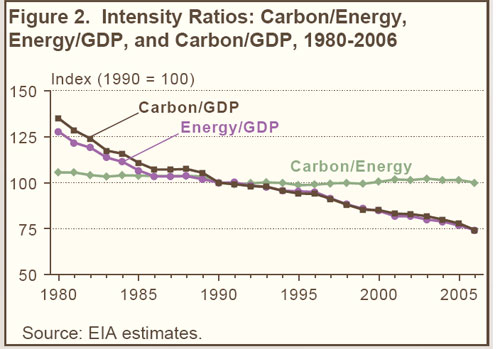New York Times columnist Gail Collins begins today’s piece with a glaring error. She says:
Didn’t know we had any goals for curbing global warming? Where were you in 2002 when the president put us on the road toward reducing the growth of greenhouse gas emissions by 18 percent by 2012?
Now, Collins spends the rest of the column deriding that goal, and the new goal Bush announced on Wed., as she should: both goals are worth deriding.
But that wasn’t what Bush announced in 2002. He didn’t propose to slow the rate of greenhouse-gas emission growth. He proposed to improve greenhouse-gas intensity of the economy by 18% by 2012.
The difference is significant. Falling GHG intensity is perfectly compatible with rising emissions, and even with a rising rate of growth of emissions — if the economy grows fast enough the efficiency gains can be swamped.
As it happens, emissions did rise, but GHG intensity did fall. Then again, it’s been falling for years, and is likely to keep falling. The salient fact, though, is that Bush had nothing at all to do with this. The EIA even admits as much:
The steady decrease in carbon intensity (carbon/GDP) has resulted mainly from reductions in energy use per unit of GDP (energy/GDP) rather than increased use of low-carbon fuels …
Here’s the graph:

My point is: the goal Collins describes is pathetic, but at least it’s a goal, a metric Bush could have moved with good policy. The goal Bush actually proposed in 2002 is even more pathetic, since it was going to happen anyway. It’s like watching a rock roll down a hill, pointing at a spot lower on the hill, and saying, "my goal is for the rock to be there in a few seconds."
Ah, Bushology: the fine distinctions between terrible and horrendous. Won’t we miss it when it’s gone.

